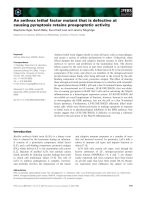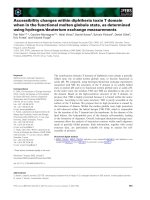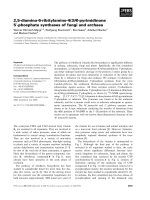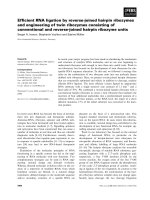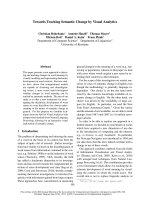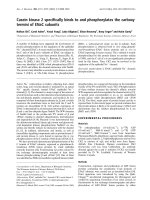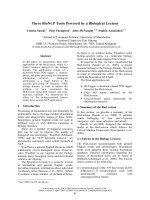Báo cáo khoa học: Cofactor-independent oxygenation reactions catalyzed by soluble methane monooxygenase at the surface of a modified gold electrode pot
Bạn đang xem bản rút gọn của tài liệu. Xem và tải ngay bản đầy đủ của tài liệu tại đây (263.68 KB, 6 trang )
Cofactor-independent oxygenation reactions catalyzed by soluble
methane monooxygenase at the surface of a modified gold electrode
Yann Astier
1
*, Suki Balendra
2
, H. Allen O. Hill
1
, Thomas J. Smith
2†
and Howard Dalton
2
1
Chemistry Department, University of Oxford, UK;
2
Department of Biological Sciences, University of Warwick, UK
Soluble methane monooxygenase (sMMO) is a three-com-
ponent enzyme that catalyses dioxygen- and NAD(P)H-
dependent oxygenation of methane and numerous other
substrates. Oxygenation occurs at the binuclear iron active
centre in the hydroxylase component (MMOH), to which
electrons are passed from NAD(P)H via the reductase
component (MMOR), along a pathway that is facilitated
and controlled by the third component, protein B (MMOB).
We previously demonstrated that electrons could be passed
to MMOH from a hexapeptide-modified gold electrode and
thus cyclic voltammetry could be used to measure the redox
potentials of the MMOH active site. Here we have shown
that the reduction current is enhanced by the presence of
catalase or if the reaction is performed in a flow-cell, prob-
ably because oxygen is reduced to hydrogen peroxide, by
MMOH at the electrode surface and the hydrogen peroxide
then inactivates the enzyme unless removed by catalase or a
continuous flow of solution. Hydrogen peroxide production
appears to be inhibited by MMOB, suggesting that MMOB
is controlling the flow of electrons to MMOH as it does in
the presence of MMOR and NAD(P)H. Most importantly,
in the presence of MMOB and catalase, the electrode-asso-
ciated MMOH oxygenates acetonitrile to cyanoaldehyde
and methane to methanol. Thus the electochemically driven
sMMO showed the same catalytic activity and regulation by
MMOB as the natural NAD(P)H-driven reaction and may
have the potential for development into an economic,
NAD(P)H-independent oxygenation catalyst. The signifi-
cance of the production of hydrogen peroxide, which is not
usually observed with the NAD(P)H-driven system, is also
discussed.
Keywords: electrochemical oxygenation; regulatory protein;
soluble methane monooxygenase.
Soluble methane monooxygenase (sMMO) catalyses
the bacterial oxidation of methane to methanol using
NAD(P)H as cofactor [1]. sMMO consists of three compo-
nents: the hydroxylase (MMOH), the reductase (MMOR)
and a regulatory protein (known as MMOB or protein B).
The active site of the enzyme is located on the a subunit of
MMOH and consists of a binuclear iron species located in a
hydrophobic pocket approximately 12 A
˚
beneath the
protein surface [2]. MMOH, which has an (abc)
2
quater-
nary structure, interacts with the MMOR component from
which it receives reductant to drive the reaction [3]:
CH
4
þ NADH þ H
þ
þ O
2
! CH
3
OH þ NAD
þ
þ H
2
O
The regulatory protein (MMOB) plays several roles in the
catalytic process including modulating the rate of electron
transfer between MMOR and MMOH [4,5], altering the
redox potential of the binuclear iron site [6], optimizing the
interaction between MMOR and MMOH [7], controlling
the access of large substrates to the active site [8] and
affecting the regioselectivity of substrate oxygenation [9,10].
The 15.9-kDa MMOB also exists in a naturally occurring
truncated form in which 12 amino acids are lost from the
N-terminus. This truncated form (MMOB
tru
) is completely
inactive within the sMMO complex [11]. The sMMO
reaction can also be driven using hydrogen peroxide via the
peroxide shunt reaction [10,12], in which case the only
protein component required is MMOH and neither NADH
nor O
2
is needed to catalyze substrate oxygenation. Indeed
MMOB, which facilitates substrate oxygenation in the
whole-complex sMMO reaction, actually inhibits the per-
oxide shunt [10]. Conversely MMOB
tru
, which has no
stimulatory effect on the whole-complex reaction, has little
effect on the peroxide shunt reaction [13].
The inability of MMOB
tru
to facilitate a catalytically
competent sMMO complex is supported by electrochemical
evidence in which MMOB was able to cause a negative shift
in redox potential of MMOH at a modified gold electrode
whereas MMOB
tru
was ineffective [6]. In these experiments
it was demonstrated that the modified electrode could serve
as the source of electrons to MMOH, thus obviating the
need for NADH and MMOR although only direct electron
transfer to the MMOH from the electrode was measured.
Correspondence to H. Dalton, Department of Biological Sciences,
University of Warwick, Coventry CV4 7AL, UK.
Fax: + 44 24 76523568, Tel.: + 44 24 76523552,
E-mail:
Abbreviations: sMMO, soluble methane monooxygenase; MMOB,
regulatory component of sMMO; MMOBtru, truncated form of
MMOB; MMOH, hydroxylase component of sMMO; MMOR,
reductase component of sMMO; SCE, saturated calomel electrode.
Enzymes: methane monooxygenase (EC 1.14.13.25).
Note: a web site is also available at />dalton/
Note: Y. Astier and S. Balendra made equal contributions to this
study.
*Present address: Oxford Biosensors, Begbroke Science Park,
Yarnton OX5 1PF, UK.
Present address: Biomedical Research Centre, Sheffield Hallam
University, Howard Street, Sheffield S1 1WB, UK.
(Received 23 September 2002, accepted 3 December 2002)
Eur. J. Biochem. 270, 539–544 (2003) Ó FEBS 2003 doi:10.1046/j.1432-1033.2003.03411.x
Here we report, for the first time since attempts were made
in the mid-1970s, that such an electron transfer can be
effectively coupled to the oxidation of hydrocarbon sub-
strate that is facilitated by the MMOB protein.
Materials and methods
Chemicals and enzymes
The MMOH and MMOR components of sMMO were
purified from Methylococcus capsulatus (Bath) as described
previously [7,14]. The regulatory protein used in all experi-
ments was a catalytically active mutant with increased
stability, in which glycine 13 was replaced by a glutamine.
Expression in Escherichia coli, affinity purification and
removal of the N-terminal affinity tag were effected as
previously reported [11]. MMOB
tru
can be prepared from
wild-type MMOB purified from M. capsulatus (Bath) by
leaving a purified sample (containing a mixture of MMOB
and MMOB
tru
) at room temperature for 2–3 days. To
ensure we had a homogeneous sample of MMOB
tru
we
made a construct for expression of MMOB
tru
in E. coli as a
fusion to glutathione S-transferase and prepared the
recombinant truncate by the same method used for the
full-length protein. Like the recombinant intact MMOB
[11], the recombinant MMOB
tru
had two additional vector-
encoded amino acids (Gly-Ser) at the N-terminus that had
no effect on its catalytic properties.
Analytical grade acetonitrile and glycolic acid nitrile
solution (70% in water) were supplied by Fluka. Analytical
grade HCl was purchased from BDH, methanol (HPLC
grade) from Prolab, and oxygen and methane (both at 99%
purity) from BOC. The water used in electrochemistry
experiments was conductivity water from Nanopure (resis-
tivity 18.2 MW cm). The hexapeptide, Lys-Cys-Thr-Cys-
Cys-Ala, used to modify the gold electrode, was synthesized
using a Pioneer Peptide synthesiser (Applied Biosystems)
and purified by means of HPLC using a Jupiter RPC18
column.
Electrochemical measurements
Voltammetric experiments were performed using a potenti-
ostat/galvanostat PGSTAT12 (Autolab) controlled by a
Dell GX110MT computer fitted with GPES software. The
surface of the 4-mm diameter gold electrode (Oxford
Electrodes) was modified by cycling the electrode at
reducing potentials in the presence of the hexapeptide, as
described previously [6], to enable electron transfer to
MMOH. The counter electrode was a platinum wire (99%
pure). Except where otherwise stated all potentials are
reported in reference to a saturated calomel electrode (SCE)
supplied by Radiometer Analytical and all experiments were
performed at 22 °Cin25m
M
Mops pH 7.0.
Cyclic voltammetry of MMOH (25 l
M
) was performed
at 2, 5, 10, 20 and 50 mVÆs
)1
between 0 and )0.6 V.
Voltammetry to investigate the effects of catalase, MMOB
and MMOB
tru
and the substrate acetonitrile on electron
transfer to MMOH was also performed between 0 and
)0.6 V, at the scan speed and protein and substrate
concentrations stated for each experiment. Where necessary,
the solution contacting the electrodes was ventilated by
means of a stream of air from an electric fan. The effect of
the substrate methane on the electrochemical properties of
the MMOH/MMOB/catalase system was investigated by
enclosing the electrode assembly in a PVC chamber in
which a 1 : 1 oxygen/methane atmosphere was maintained.
Detection of the products of substrate oxygenation by the
adsorbed MMOH was achieved by holding the potential at
)0.5 V for 30 min in the presence of substrate and then
removing the liquid (50 lL) from the electrode surface for
analysis by GC/MS using a Hewlett-Packard HP 5890A gas
chromatograph coupled to a Trio 1000 mass spectrometer.
Products were identified by reference to authentic samples.
For the flow cell experiments, eight 1-mm diameter gold
electrodes were cast in epoxy resin and polished to mirror
finish. All electrodes were modified with hexapeptide and
four had MMOH adsorbed as well. A potential of
) 500 mV vs. the 1
M
KCl Ag/AgCl electrode (equivalent
to approximately )520 mV relative to the SCE) was applied
to all electrodes. The counter electrode was a platinum mesh
and a silver wire was used a reference. Each electrode was
monitored individually by a potentiostat. A peristaltic
pump, P500, from Pharmacia, was used to maintain a flow
of 0.1
M
Tris/H
2
SO
4
, pH 7.4, at the electrode surfaces.
Results
Direct electrochemistry of the MMOH on the hexapeptide-
modified gold electrode from 0 to )0.6 V at various scan
rates between 2 mVÆs
)1
and 50 mVÆs
)1
indicated the redu-
cibility of the binuclear iron centre and its reoxidation by
dissolved oxygen (Fig. 1). The reduction current peak
intensities varied linearly with the square root of the scan
Fig. 1. Cyclic voltammetry of MMOH in solution showing current (I)
vs. applied potential (E). Scans were performed at scanning rates (v)of2
(solid line), 5 (dotted line), 10 (broken line), 20 (broken/dotted line) and
50 (dashed line) mVÆs
)1
,from0to)0.6 V, using 25 lL of MMOH
solution (25 l
M
). Peaks currents were linear with respect to the square
root of the scan rate, consistent with a diffusion-controlled electron
transfer (insert).
540 Y. Astier et al.(Eur. J. Biochem. 270) Ó FEBS 2003
rate (see inset to Fig. 1), which agreed with our earlier
observation [6] and was indicative of a diffusional reaction.
During cyclic voltammetry the reduction current changed
from a diffusion-limited current to one in which the current
indicated (by being directly proportional to the scan rate)
that the MMOH protein was absorbed onto the electrode.
This was confirmed after repeated cycling for 40 min
(Fig. 2). The signal remained unchanged after rinsing the
electrode and undertaking cyclic voltammetry in protein-
free 0.1
M
Tris/H
2
SO
4
buffer, pH 7.4. Thus it was possible
to evaluate the rate of electron transfer to MMOH from the
equation: i/nFA ¼ k
f
C
o
where i is the current intensity in
amperes, n is the number of electrons exchanged (n ¼ 2for
the sMMO system), F is the Faraday constant, A is the
electrode area in cm
2
, C
o
is the enzyme concentration in the
thin layer in molÆcm
)3
and k
f
is the potential-dependent
electron transfer constant in s
)1
. Using the values of the
current (from which the background current had been
subtracted), we can estimate that k
f
for electron transfer to
MMOH is (3.0 ± 0.6) · 10
)5
s
)1
. When the experiment
was repeated in a flow cell in which the liquid phase was
flowed over the electrode, the reduction current proved to be
flow-rate dependent. In the presence of adsorbed MMOH
the current was 10 times greater than the control in the
absence of adsorbed protein, suggesting that renewing the
solution at the electrode surface increased the reduction
current significantly. One possibility might be that an
inhibitory product was formed by MMOH but that it was
readily removed in the flow-cell experiment.
As dioxygen is a substrate in sMMO-catalyzed reactions,
it was possible that the product that was inhibiting current
flow in the static cell experiments was a reduced oxygen
species. Addition of catalase to the static cell with the
MMOH-adsorbed electrode resulted in a catalase-depend-
ent increase in reduction current that appeared to be
diffusion controlled, as evidenced by the increase in current
when the solution was ventilated (Fig. 3). These data
strongly suggested that hydrogen peroxide was responsible
for the lack of catalytic current in the absence of catalase,
presumably because the hydrogen peroxide inactivated
MMOH.
Addition of MMOB to the MMOH-activated electrode
produced an increase in current intensity that was propor-
tional to the concentration of MMOB up to a molar ratio of
2 : 1 MMOB:MMOH (Fig. 4). The electron transfer rate k
f
was approximately doubled to (6.2 ± 1.0) · 10
)5
s
)1
.Ifthe
inactive truncate MMOB
tru
wasaddedthennoeffectonthe
Fig. 2. Cyclic voltammetry during MMOH adsorption. Repeated cyclic
voltammetry was performed at 5 mVÆs
)1
from 0 to )0.6 V, using
25 lL of MMOH solution (25 l
M
). The arrow indicates the evolution
of the reduction waves over 40 min.
Fig. 3. MMOH activation by catalase and oxygen. MMOH was
adsorbed onto the electrode as shown in Fig. 2 and then cycled from 0
to )0.6 V at 2 mVÆs
)1
. The arrow shows the effect of increasing
catalase concentrations (0, 2.4, 4.8 and 7.2 l
M
, respectively). The effect
of ventilating the reaction at the highest catalase concentration was
also investigated as shown.
Fig. 4. Effect of MMOB on the electrochemistry of MMOH.
Adsorbed MMOH (prepared as in Fig. 2) was cycled from 0 to )0.6 V
at 5 mVÆs
)1
. Aliquots of MMOB solution (8 l
M
) were added to give
MMOB : MMOH molar ratios of 0, 0.5, 1, 1.3, 2, 2.5 and 3.5; the
arrow shows the effect of increasing concentration of MMOB.
Ó FEBS 2003 Electrochemical oxygenation using sMMO (Eur. J. Biochem. 270) 541
electron transfer was detected, the constant k
f
being the
same as that observed with MMOH alone (data not shown).
When an excess of catalase was added to the MMOH/
MMOB complex the current remained unchanged (Fig. 5).
We assume from this that the presence of MMOB
suppressed the production of hydrogen peroxide by
MMOH. In the presence of MMOB
tru
, however, catalase
produced a marked increase in the negative current (data
not shown) indicating that MMOB in its fully active form
prevents hydrogen peroxide formation but its inactive form
(MMOB
tru
) is unable exert such an effect. In the presence of
catalase, a large increase in reduction current was observed
upon addition of the substrate acetonitrile (Fig. 5), consis-
tent with the substrate-induced passage of electrons to
MMOH during turnover. Acetonitrile produced only a
modest increase in reduction current when MMOB was
replaced by the inactive MMOB
tru
(data not shown).
When the substrates methane or acetonitrile were added
to the MMOH/MMOB (1 : 2) complex in the absence of
catalase and the electrode was held at a negative potential
for 30 min to enable any oxidation products to accumulate
(as described in materials and methods), no such products
were observed. However, when catalase was added to
50 l
M
, then product (methanol or cyanoaldehyde) was
readily observed by gas chromatography that was con-
firmed by mass spectrometry. No product was observed
with MMOH alone or when MMOB
tru
was added instead
of MMOB.
The reactions inferred to occur at the MMOH-activated
electrode under the various conditions tested are summar-
ized in Table 1.
Discussion
For the first time we have demonstrated that it is possible to
use an electrochemical method to drive the oxidation of
methane by two components of the sMMO complex
(MMOH and MMOB) in the absence of reductant (NADH
or NADPH) and MMOR. As in the natural sMMO
reaction [11], substrate oxygenation was facilitated by
MMOB but not the truncated form MMOB
tru
. Unlike
the natural system, however, the conditions for a successful
reaction in the electrochemically driven sMMO require that
catalase is also present (Table 1).
Fromthesedataitisapparentthathydrogenperoxideis
produced during the electrochemical oxidation and so it is
relevant to ask how the hydrogen peroxide is formed and
what role, if any, it plays in the oxygenation reaction.
When catalase was added to the hexapeptide-modified
electrode to which MMOH had been absorbed we
observed a large increase in the negative current compared
to the control in which no catalase was present (Fig. 3).
We conclude that during the reduction cycle hydrogen
peroxide was formed that could be either removed by
catalase or its effect diminished by constant removal in the
flow cell. We have also observed production of hydrogen
peroxide when the complete sMMO complex was exposed
to a high concentration of oxygen (Y. Jiang and H. Dalton,
unpublished observations). Here again, addition of catalase
would restore full activity through its ability to remove the
toxic hydrogen peroxide. Thus it appears that hydrogen
peroxide is formed when MMOH is either over-reduced
(as seen in the electrochemical experiments) or over-
oxidized when exposed to excess oxygen. This release of
hydrogen peroxide under these extreme conditions may
Table 1. Reactions at the MMOH-activated electrode.
Components Effect of catalase Reaction(s) inferred
a
MMOH Catalytic current increased O
2
+2H
+
+2e
–
fi H
2
O
2
MMOH + MMOB None None
MMOH + MMOB
tru
Catalytic current increased O
2
+2H
+
+2e
–
fi H
2
O
2
MMOH + MMOB + substrate Catalytic current increased; (a) O
2
+2H
+
+2e
–
fi H
2
O
2
oxygenated product observed
b
(b) substrate + O
2
+2H
+
+2e
–
fi oxygenated product + H
2
O
MMOH + MMOB
tru
+ substrate No product observed
in the presence of catalase
Oxygenation reaction (b) did not occur
a
As detailed in the text, oxygenated products were detected by GC-MS and production of hydrogen peroxide was inferred from an increase
in catalytic current upon addition of catalase.
b
As hydrogen peroxide from reaction (a) inactivated the enzyme, oxygenated product from
reaction (b) accumulated only when catalase was present.
Fig. 5. Effect of catalase, MMOB and acetonitrile on the electro-
chemistry of the MMOH/MMOB complex. Adsorbed MMOH/
MMOB (1 : 2 molar ratio) complex (prepared as in Fig. 4) was cycled
from 0 to )0.6Vat5mVÆs
)1
(solid line). Data were also collected after
addition of catalase (to 50 l
M
; dotted line) and subsequent addition of
acetonitrile (to 95 l
M
; broken line).
542 Y. Astier et al.(Eur. J. Biochem. 270) Ó FEBS 2003
arise as a result of interaction of reductant or oxidant with
intermediate P in the catalytic cycle, which is believed to
contain a binuclear iron site-associated peroxo species [5].
Addition of MMOB permits an increase in electron flow to
MMOH and also appears to regulate and shutdown the
production of hydrogen peroxide as there was no change
in the current intensity when catalase is added to the
MMOH/MMOB complex. It is possible that a confor-
mational change in the MMOH protein is necessary to
stop overproduction of hydrogen peroxide and that this is
induced by MMOB, although not by MMOB
tru
. Earlier
studies by small-angle X-ray scattering spectroscopy
(SAXS) have also shown that such a conformational
change is induced by the active MMOB and not MMOB
tru
[7].
The most interesting result arises when substrate (either
methane or acetonitrile) is added to the system. Product was
only observed when MMOH/MMOB and catalase were
present (Table 1). In the absence of catalase or MMOB no
product was formed. It is possible to rationalize these
observations by proposing a possible new role for MMOB
and hydrogen peroxide. As indicated above we suggest that
MMOB normally serves to shut down hydrogen peroxide
formation in the absence of oxidizable substrate. In the
presence of substrate, however, catalase is essential for the
formation of product as hydrogen peroxide is toxic. We
postulate that one role for MMOB is to act as a sensor for
substrate. In the absence of substrate, MMOB can stimulate
electron transfer from the electrode to MMOH but it does
not result in hydrogen peroxide formation because there is
no substrate present. When substrate is present we observe
formation of both hydrogen peroxide and product. The
paradox that needs to be resolved here is if hydrogen
peroxide production is shut down by MMOB why is it
observed when substrate is added? Here the sensor role of
MMOB may come into play. We postulate that a complex is
formed between MMOB/MMOH and substrate that is
different from that in the absence of substrate. In this
substrate-associated complex the active site now permits an
interaction between the substrate and the active oxygen
species to generate product.
Previous data have led to the conclusion that the species
responsible for oxygenation of substrate is the diferryl
intermediate Q, which forms after intermediate P during
single-turnover kinetics [15,16]. As, under appropriate
conditions, hydrogen peroxide is known to oxidize methane
directly to form methanol [17], the data presented here
permit the alternative conclusion that intermediate Q may
be the result of a side reaction and hydrogen peroxide per se
is effecting the oxidation of substrate. Indeed the reactivity
of hydrogen peroxide may well be far greater in its
nonaquated form within the highly hydrophobic pocket
adjacent to the binuclear iron centre [2,18] than aquated
hydrogen peroxide in the bulk solution. The need for
catalase in the electrochemically driven reaction is therefore
to protect the protein from inactivation by excess hydrogen
peroxide that has escaped from the enzyme and become
aquated, whilst methane oxidation may be catalysed by
nonaquated hydrogen peroxide at the active site.
A further complication arises when one considers that
hydrogen peroxide is able to drive methane oxidation to
methanol by MMOH alone via the peroxide shunt reaction
[10]. Why is hydrogen peroxide not inhibitory under these
circumstances? The answer, we believe, is quite straightfor-
ward. In the electrochemical experiments hydrogen peroxide
is being generated as an intermediate in low levels. It is only
formed under two circumstances: (a) when MMOH is
absorbed to the electrode in the absence of full-length
MMOB and (b) when the MMOH, active MMOB and
substrate are all present. In the first instance this is a simple
unregulated formation of hydrogen peroxide due to over-
reduction of the enzyme at the electrode. In the second
instance the hydrogen peroxide is formed as a catalytic
intermediate. The peroxide shunt reaction is based entirely
upon Le Chatelier’s principle. Free hydrogen peroxide is
inhibitory, but to drive the reaction high concentrations are
needed to form intermediate P. The catalytic efficiency of
the peroxide shunt reaction is not high, the maximum rate
of methane oxygenation being only approximately 10% of
that observed with the whole sMMO system; moreover, the
enzyme becomes inactivated as the peroxide shunt reaction
proceeds [10].
MMOB (and not MMOB
tru
) is inhibitory to the peroxide
shunt reaction [10] but is required for the whole-complex
sMMO reaction and for the electrochemical reaction here.
These observations can be explained if it is presumed that
MMOB has two effects during the catalytic cycle of sMMO,
a stimulatory role before compound P formation and an
inhibitory role thereafter. Thus, the stimulatory effect of
MMOB predominates when the oxidant is dioxygen and
electrons (from MMOR or the modified gold electrode) are
required for formation of compound P. In the peroxide
shunt reaction, however, the natural pathway to compound
P is bypassed and so only the later, inhibitory effect of
MMOB is observed. Consistent with this hypothesis, fast-
reaction kinetics have shown that MMOB accelerates
compound P formation by approximately 1000-fold [19],
whilst steady-state experiments have shown that MMOB
stimulates whole-complex sMMO activity at low molar
ratios with respect to MMOH, but begins to inhibit it when
the MMOB : MMOH molar ratio exceeds 2 [20].
In conclusion we observe that methanol is formed from
methane by MMOH and MMOB when absorbed to an
electrode surface, via a reaction that may involve hydrogen
peroxide as an important intermediate. Conformational
changes in MMOH induced by MMOB appear to be
critical in the catalytic cycle.
Acknowledgements
This work was funded by the Biotechnology and Biological Sciences
Research Council (BBSRC) and British Gas PLC through a Hub
studentship (to S.B). We thank Susan Slade for expert technical
assistance during protein purification.
References
1. Colby, J. & Dalton, H. (1978) Resolution of the methane mono-
oxygenase of Methylococcus capsulatus (Bath) into three compo-
nents. Biochem. J. 171, 461–468.
2. Rosenzweig, A.C., Frederick, C.A., Lippard, S.J. & Nordlund, P.
(1993) Crystal structure of a bacterial nonheme iron hydroxylase
that catalyzes the biological oxidation of methane. Nature 366,
537–543.
Ó FEBS 2003 Electrochemical oxygenation using sMMO (Eur. J. Biochem. 270) 543
3. Lund, J., Woodland, M.P. & Dalton, H. (1985) Electron transfer
reactions in the soluble methane monooxygenase of Methylo-
coccus capsulatus (Bath). Eur. J. Biochem. 147, 297–305.
4. Green, J. & Dalton, H. (1985) Protein B of soluble methane
monooxygenase from Methylococcus capsulatus (Bath). J. Biol.
Chem. 260, 15795–15801.
5. Liu, K.E., Valentine, A.M., Qiu, D., Edmondson, D.E., Apple-
man, E.H., Spiro, T.G. & Lippard, S.J. (1995) Characterisation of
a diiron (III) peroxo intermediate in the reaction cycle of methane
monooxygenase hydroxylase from Methylococcus capsulatus
(Bath). J. Am. Chem. Soc. 117, 4997–4998.
6. Kazlauskaite, H., Hill, H.A.O., Wilkins, P.C. & Dalton, H. (1996)
Direct electrochemistry of the hydroxylase of soluble methane
monooxygenase from Methylococcus capsulatus (Bath). Eur. J.
Biochem. 241, 552–556.
7. Gallagher, S.C., Callaghan, A.J., Zhao, J., Dalton, H. & Trewhella,
J. (1999) Global conformational changes control the reactivity of
methane monooxygenase. Biochemistry 38, 6752–6760.
8. Wallar, B.J. & Lipscomb, J.D. (2001) Methane monooxygenase
component B mutants alter the kinetics of steps throughout the
catalytic cycle. Biochemistry 40, 2220–2233.
9. Froland,W.A.,Andersson,K.K.,Lee,S K.,Liu,Y.&Lipscomb,
J.D. (1992) Methane monooxygenase component B and reductase
alter the regioselectivity of the hydroxylase component-catalysed
reactions. J. Biol. Chem. 267, 17588–17597.
10. Jiang, Y., Wilkins, P.C. & Dalton, H. (1993) Activation of the
hydroxylase of sMMO from Methylococcus capsulatus (Bath) by
hydrogen peroxide. Biochim. Biophys. Acta 1163, 105–112.
11. Lloyd, J.S., Bhambra, A., Murrell, J.C. & Dalton, H. (1997)
Inactivation of the regulatory protein B of soluble methane
monooxygenase from Methylococcus capsulatus (Bath) by pro-
teolysis can be overcome by a Gly to Gln modification. Eur. J.
Biochem. 248, 72–79.
12. Andersson,K.K.,Froland,W.A.,Lee,S K.&Lipscomb,J.D.
(1991) Dioxygen independent oxygenation of hydrocarbons by
methane monooxygenase hydroxylase component. New J. Chem.
15, 411–415.
13. Callaghan, A.J., Smith, T.J., Slade, S.E. & Dalton, H. (2002)
Residues near the N-terminus of protein B control autocatalytic
proteolysis and the activity of soluble methane mono-oxygenase.
Eur. J. Biochem. 269, 1835–1843.
14. Pilkington, S.J. & Dalton, H. (1990) Soluble methane mono-
oxygenase from Methylococcus capsulatus Bath. Methods
Enzymol. 188, 181–190.
15. Lee, S K., Nesheim, J.C. & Lipscomb, J.D. (1993) Transient in-
termediates of the methane monooxygenase catalytic cycle. J. Biol.
Chem. 268, 21569–21577.
16. Shu, L., Nesheim, J.C., Kauffmann, K., Mu
¨
nck, E., Lipscomb,
J.D.&Que,L.(1997)AnFe
IV
2
O
2
diamond core structure for
the key intermediate Q of methane monooxygenase. Science 257,
515–518.
17. Nagiev, T.M., Faradzhev, E.G. & Mamedov, E.M. (2001) Oxi-
dation of methane to methanol by hydrogen peroxide under
pressure. Russ. J. Phys. Chem. 75, 43–48.
18. George, A.R., Wilkins, P.C. & Dalton, H. (1996) A computational
investigation of the possible substrate binding sites in the hydro-
xylase of soluble methane monooxygenase. J. Mol. Catal. B 2,
103–113.
19. Liu, Y., Nesheim, J.C., Lee, S K. & Lipscomb, J.D. (1995) Gating
effects of component B on oxygen activation by the methane
monooxygenase hydroxylase component. J. Biol. Chem. 270,
24662–24665.
20. Gassner, G.T. & Lippard, S.J. (1999) Component interactions in
the soluble methane monooxygenase from Methylococcus capsu-
latus (Bath). Biochem. 38, 12768–12785.
544 Y. Astier et al.(Eur. J. Biochem. 270) Ó FEBS 2003
